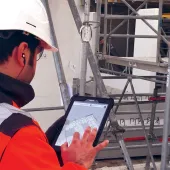AI tool aids reinforced concrete bridge safety
ETH Zurich and Swiss Railways test AI for safer concrete bridges
Researchers at ETH Zurich are working with Swiss Federal Railways (SBB) to develop artificial intelligence (AI) tools that support the design, assessment and long-term maintenance of reinforced concrete bridges.
The project focuses on rigid frame railway bridges, a common bridge type in Switzerland that also features widely in the UK rail and road networks. The AI models are designed to help engineers prioritise maintenance work and extend the service life of ageing structures, reducing unnecessary interventions and supporting more efficient use of resources.
“We’re developing a tool that helps to keep bridges in operation for as long as possible and therefore to conserve resources without running a disproportionate risk of accident,” says Sophia Kuhn, a doctoral researcher in concrete structures and bridge design at ETH Zurich.
Kuhn, working with colleagues and co-supervisors in computer science and civil engineering, developed a machine learning model that quickly assesses whether a bridge is structurally critical. The model also provides a measure of confidence in its predictions, helping engineers decide when to proceed with more detailed structural assessments.

Focus on reinforced concrete structures
The AI model was trained using data from existing SBB bridge stock and parametric simulations. It predicts the degree of structural load capacity and helps bridge owners prioritise inspections or interventions.
“Engineers often don’t know whether refined analysis will be worth the effort,” says Kuhn. “Our AI tool can assess whether the cost involved is justified.”
A second project, also led by ETH Zurich, explored how generative AI can assist in the design of new bridge structures. Instead of the traditional iterative approach, where a design is tested and adjusted repeatedly, the AI assistant takes the desired outcomes and boundary conditions and suggests suitable bridge designs.
A pedestrian bridge in St. Gallen, known as the Wiborada Bridge, was used as a case study. The AI generated several design options that balanced safety, sustainability, and environmental constraints.
Kuhn notes: “The AI assistant supports engineers but does not replace them. It’s about interaction – the final decision always lies with the design team.”
The research team has also created an open-source toolkit for engineers and architects, aimed at making AI-based methods accessible with minimal coding. The toolkit supports both forward modelling and generative design and is intended to promote more efficient, data-driven planning in the construction sector.
While the tools were developed in a Swiss context, they highlight growing opportunities for AI in concrete infrastructure worldwide – including in the UK, where many concrete bridges are reaching the end of their design lives.
ETH Zurich plans to continue refining the tools in collaboration with industry and hopes to expand their use in practical bridge engineering in the coming years.







